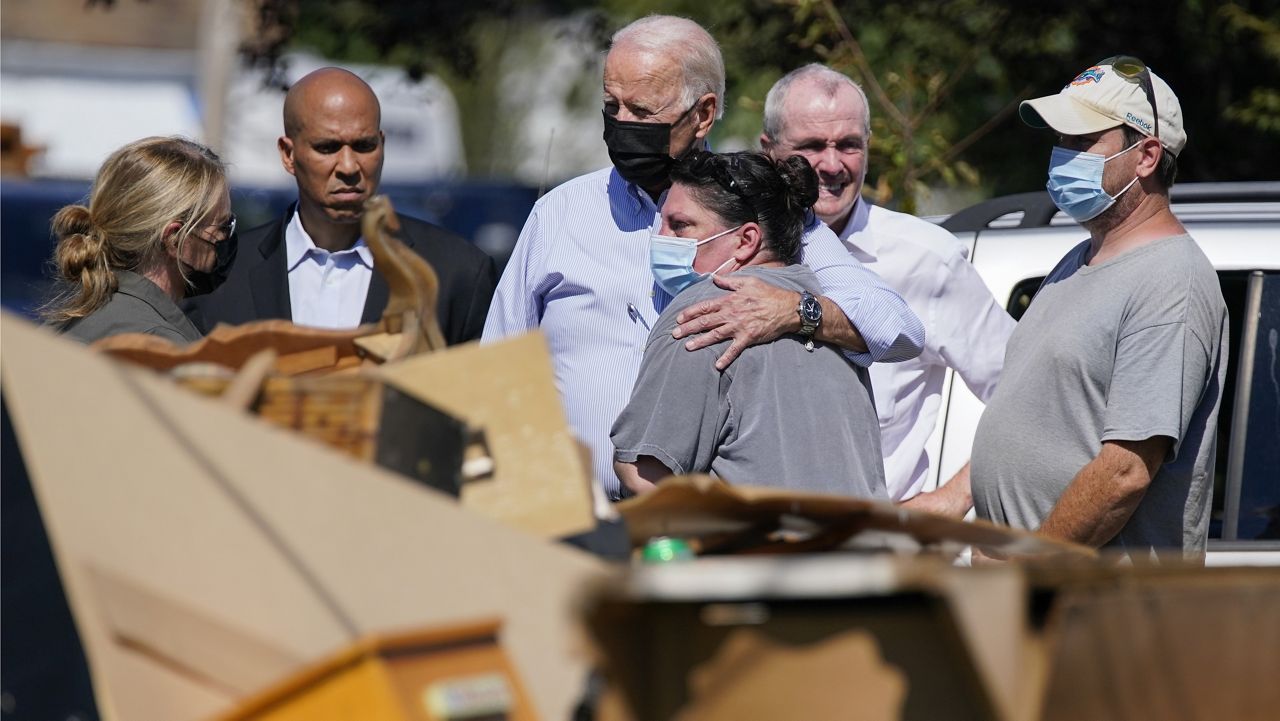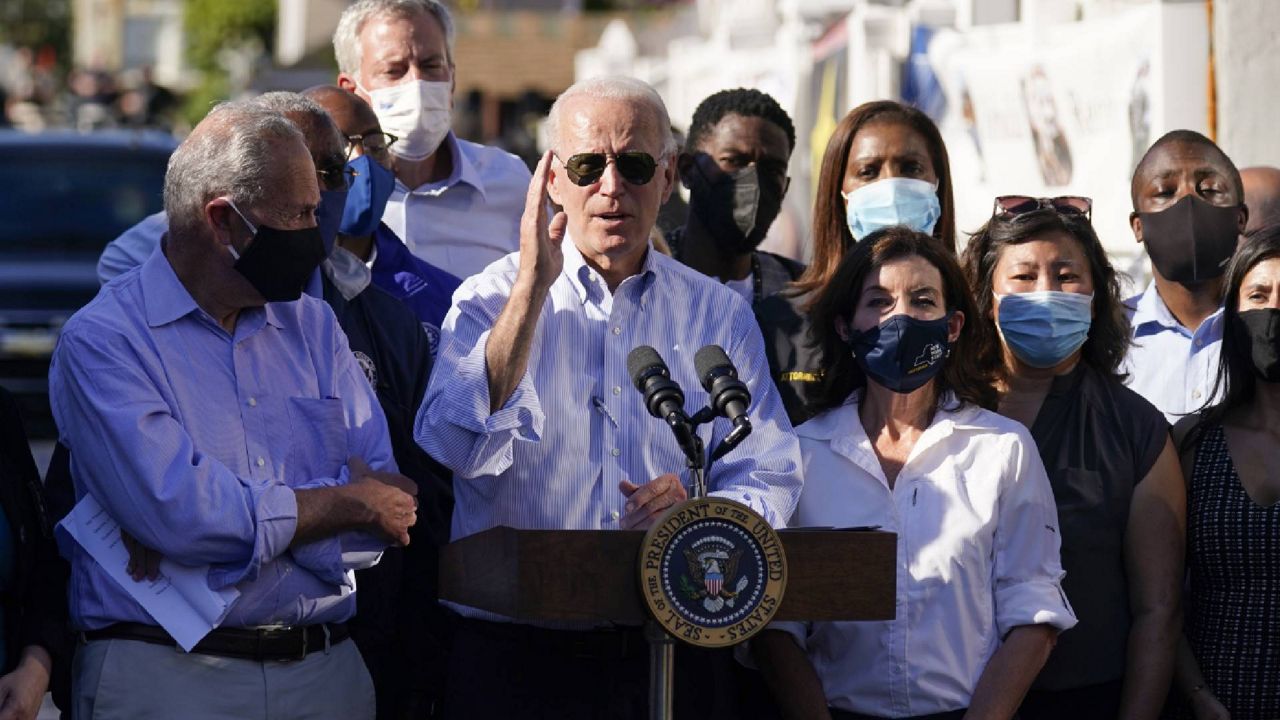As President Joe Biden toured deadly Northeast flood damage Tuesday, he said he was thinking about the all families who suffered “profound” losses from the powerful remnants of Hurricane Ida and pointed the finger at climate change for extreme weather events.
What You Need To Know
- President Joe Biden surveyed damage in parts of the northeast that suffered catastrophic flooding from the remnants of Hurricane Ida
- Biden toured neighborhoods in Manville, New Jersey, and Queens, New York, on Tuesday and received a briefing from New Jersey officials Tuesday afternoon
- More than two dozen people died in New Jersey; in New York City, 13 people lost their lives, including 11 in the borough of Queens
- Biden says Ida and other storms make federal spending on infrastructure an urgent priority as climate change becomes apparent
Biden was in the Northeast to survey the aftermath and call for federal spending to fortify infrastructure to better defend people and property from future storms in the region and far beyond.
He called the evident impact of climate change "code red" for the United States and the world.
"I know these disasters aren't going to stop. They're only gonna come with more frequency and ferocity," he said, pointing to the two pieces of his agenda moving through Congress as Senate Majority Leader Chuck Schumer stood beside him, including his $1 trillion infrastructure plan.
He sent a message to people impacted by Ida and other disasters: "We're not leaving. We're going to continue to shout as long as it takes to get real progress here, folks."
Biden was also joined in Queens by New York Governor Kathy Hochul, New York City Mayor Bill de Blasio, New York Senator Kirsten Gillibrand and several members of Congress.
"This is everybody's crisis," he said, noting that the threat from wildfires, hurricanes, tornadoes, flooding and other extreme weather must be dealt with in ways that will lessen the devastating effects of climate change.
The president also announced he would soon travel to California to survey the damage done by wildfires in the region.
“Every part of the country, every part of the country is getting hit by extreme weather,” Biden said earlier in a briefing at the Somerset County emergency management training center attended by federal, state and local officials, including New Jersey Gov. Phil Murphy.
“We can’t turn it back very much, but we can prevent it from getting worse,” he said, adding added that scientists have been warning for decades that this day would come and that urgent action was needed.
The White House also asked Congress Tuesday for $24 billion help fund natural disaster recovery, including $10 billion for Ida response.
In New Jersey, President Biden also walked along a street in the Lost Valley neighborhood of Manville, where cleanup continues after the Raritan River overflowed its banks. Many front lawns were covered with water-logged couches, pianos, crumbled plaster and other debris.

One home displayed a hand-painted sign that said, “Manville will be back better.”
Biden, wearing a mask, spoke to adults and children, including a woman who stood in front of her home that was destroyed by fire as the flood occurred. She told the president she and her husband had left early because they have a baby.
“Thank God you’re safe,” Biden replied. As he walked the route, Biden was taunted by supporters of Republican former President Donald Trump, but the president did not look in their direction.
At the briefing, Biden focused on the personal calamities, saying, “The losses that we witnessed today are profound. My thoughts are with all those families affected by the storm and all those families who lost someone they love.”
At least 50 people were killed in six Eastern states as record rainfall last week overwhelmed rivers and sewer systems. Some people were trapped in fast-filling basement apartments and cars, or were swept away as they tried to escape. The storm also spawned several tornadoes.
More than half of those deaths, 27, were recorded in New Jersey. In New York City, 13 people were killed, including 11 in Queens.
New Jersey Gov. Phil Murphy urged FEMA Tuesday to authorize more area counties for disaster assistance, which means they can get direct federal funding for recovery.
"I know FEMA is on the ground today, and we're desperately hoping that some more counties get added to that list," Murphy said.
Biden's visit follows a Friday trip to Louisiana, where Hurricane Ida first made landfall, killing at least 13 people in the state and plunging New Orleans into darkness. Power is being slowly restored.
Manville, situated along New Jersey’s Raritan River, is almost always hard-hit by major storms. It was the scene of catastrophic flooding in 1998 as the remnants of Tropical Storm Floyd swept over New Jersey. It also sustained serious flooding during the aftermath of Hurricane Irene in 2011 and Superstorm Sandy in 2012.
Biden has approved major disaster declarations, making federal aid available for people in six New Jersey counties and five New York counties affected by the devastating floods. He is open to applying the declaration to other storm-ravaged New Jersey counties, White House spokesperson Jen Psaki said.
Both Murphy and New York Mayor Bill de Blasio spent part of Labor Day touring damaged communities. Deanne Criswell, the former New York City emergency management director, now in charge at the Federal Emergency Management Agency, joined the mayor.
Biden also used his appearance in Louisiana to pitch his plan, pending in Congress, to spend $1 trillion on modernizing roads, bridges, sewers and drainage systems, and other infrastructure to make them better able to withstand the blows from major storms.
Past presidents have been defined in part by how they handle such crises, and Biden has seen several weather-induced emergencies in his short presidency, starting with a February ice storm that caused the power grid in Texas to fail. He has also been monitoring wildfires in the West.
The White House has sought to portray Biden as in command of the federal response to these natural disasters, making it known that he is getting regular updates from his team and that he is keeping in touch with governors and other elected officials in the affected areas.
As president, Donald Trump casually lobbed paper towels to people in Puerto Rico after Hurricane Maria’s devastation in 2017, generating scorn from critics but little damage to his political standing. Barack Obama hugged New Jersey Republican Gov. Chris Christie after Superstorm Sandy in 2012, a brief respite from partisan tensions that had threatened the economy. George W. Bush fell out of public favor due to a poor response after Hurricane Katrina swamped New Orleans in 2005.
Ida was the fifth-most powerful storm to hit the U.S. when it made landfall in Louisiana on Aug. 29. The storm’s remnants dropped devastating rainfall across parts of Maryland, Pennsylvania, New York and New Jersey, causing significant disruption in major cities.
The Associated Press contributed to this report.



